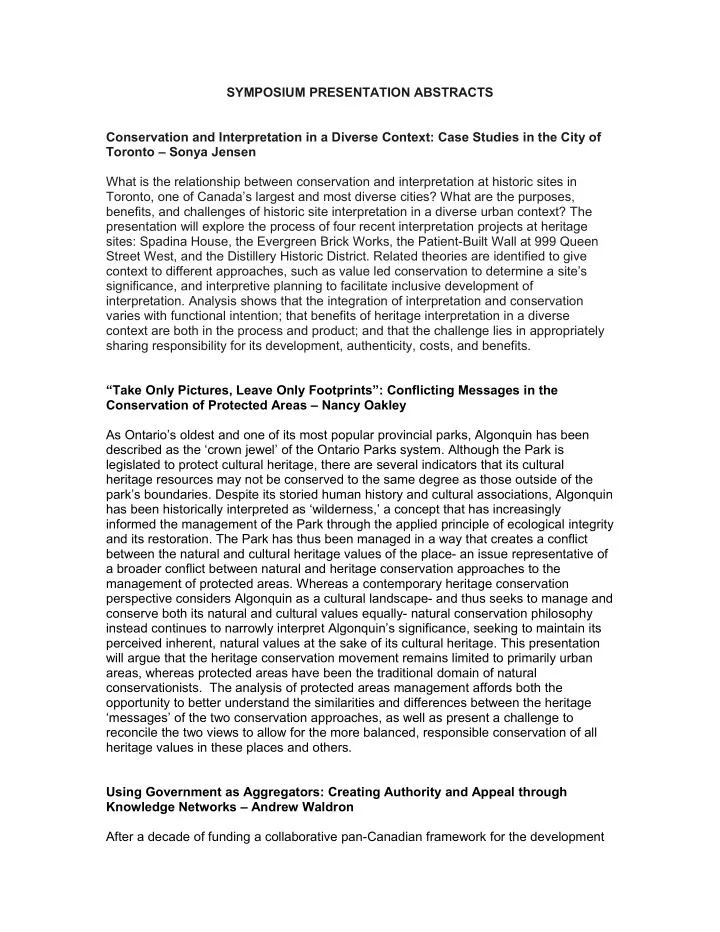

SYMPOSIUM PRESENTATION ABSTRACTS Conservation and Interpretation in a Diverse Context: Case Studies in the City of Toronto – Sonya Jensen What is the relationship between conservation and interpretation at historic sites in Toronto, one of Canada’s largest and most diverse cities? What are the purposes, benefits, and challenges of historic site interpretation in a diverse urban context? The presentation will explore the process of four recent interpretation projects at heritage sites: Spadina House, the Evergreen Brick Works, the Patient-Built Wall at 999 Queen Street West, and the Distillery Historic District. Related theories are identified to give context to different approaches, such as value led conservation to determine a site’s significance, and interpretive planning to facilitate inclusive development of interpretation. Analysis shows that the integration of interpretation and conservation varies with functional intention; that benefits of heritage interpretation in a diverse context are both in the process and product; and that the challenge lies in appropriately sharing responsibility for its development, authenticity, costs, and benefits. “Take Only Pictures, Leave Only Footprints”: Conflicting Messages in the Conservation of Protected Areas – Nancy Oakley As Ontario’s oldest and one of its most popular provincial parks, Algonquin has been described as the ‘crown jewel’ of the Ontario Parks system. Although the Park is legislated to protect cultural heritage, there are several indicators that its cultural heritage resources may not be conserved to the same degree as those outside of the park’s boundaries. Despite its storied human history and cultural associations, Algonquin has been historically interpreted as ‘wilderness,’ a concept that has increasingly informed the management of the Park through the applied principle of ecological integrity and its restoration. The Park has thus been managed in a way that creates a conflict between the natural and cultural heritage values of the place- an issue representative of a broader conflict between natural and heritage conservation approaches to the management of protected areas. Whereas a contemporary heritage conservation perspective considers Algonquin as a cultural landscape- and thus seeks to manage and conserve both its natural and cultural values equally- natural conservation philosophy instead continues to narrowly interpret Algonquin’s significance, seeking to maintain its perceived inherent, natural values at the sake of its cultural heritage. This presentation will argue that the heritage conservation movement remains limited to primarily urban areas, whereas protected areas have been the traditional domain of natural conservationists. The analysis of protected areas management affords both the opportunity to better understand the similarities and differences between the heritage ‘messages’ of the two conservation approaches, as well as present a challenge to reconcile the two views to allow for the more balanced, responsible conservation of all heritage values in these places and others. Using Government as Aggregators: Creating Authority and Appeal through Knowledge Networks – Andrew Waldron After a decade of funding a collaborative pan-Canadian framework for the development
of a “Register of Registers”, the Canadian Register of Historic Places has established an evolving yet accurate snapshot of Canada’s historic places. With an emphasis on holistic values of historic significance reflected in character defining elements of historic places, this list is one of the world’s most accessible and comprehensive registers to date. This national initiative was successful in its goal of creating core tools for use by and engagement of the general public. However, as government roles change in society and a generation of heritage professionals in the public sector retire, a different approach must be taken. For the Canadian Register, drawing crowds together to develop new allegiance and support for heritage is a matter of course for it to remain relevant and accurate. While expert collaboration remains a significant source of authority for the heritage community, next steps for all voices in heritage is to share that authority to create deeper knowledge of historic places. This approach to improving and gaining trust by involvement with the Canadian Register may have its risks in the traditional sense of authority. Yet today it is necessary to remain relevant. The Voices of Heritage Conservation: The Canadian Association of Heritage Professionals (CAHP) – Laurie Smith The Canadian Association of Heritage Professionals is a national organization that represents the interests of professionals working in heritage conservation. Founded in 1987, CAHP has almost 300 members nationwide and continues to grow. CAHP members are highly qualified leaders in the practice of heritage conservation, working on major projects across the country. CAHP is one of Canada’s significant “heritage voices”, working to share and disseminate the message of heritage conservation. Part of CAHP’s mission is to enhance awareness of and appreciation for heritage resources and the contributions of heritage consultants, and to foster communication between heritage practitioners, public agencies and the public. CAHP encourages the use of qualified heritage professionals and adherence to heritage standards and guidelines for projects that impact on heritage resources. CAHP is currently in the process of moving its head office to Ottawa, in order to enhance its role as a national voice for heritage conservation. CAHP has recently executed a Memorandum of Understanding with Public Works and Government Services Canada with the goal of advancing heritage conservation practice in Canada. The MOU supports collaborative efforts between CAHP and PWGSC such as the exchange of information and the development of communications tools and protocols. CAHP is currently working with PWGSC to develop specific initiatives under the MOU. “Got Heritage?” – Sophie Béraud Why is it that most Canadians can name a few World Heritage or even National Historic Sites, yet struggle with listing places of significance within their own municipalities? The lack of an effective communications strategy within the heritage conservation field has translated into a lack of direction for the public to follow. A public relations campaign that markets heritage products as essential commodities is required to effectively reach target audiences. Looking at successful ad campaigns such as “Got Milk?” we examine how photography can play an essential role in encouraging the consumption (i.e. protection) of local heritage.
Recommend
More recommend